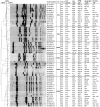Molecular analysis of human and canine Staphylococcus aureus strains reveals distinct extended-host-spectrum genotypes independent of their methicillin resistance
- PMID: 23160118
- PMCID: PMC3553761
- DOI: 10.1128/AEM.02704-12
Molecular analysis of human and canine Staphylococcus aureus strains reveals distinct extended-host-spectrum genotypes independent of their methicillin resistance
Abstract
Staphylococcus aureus causes a wide range of infectious diseases in humans and various animal species. Although presumptive host-specific factors have been reported, certain genetic lineages seem to lack specific host tropism, infecting a broad range of hosts. Such Extended-Host-Spectrum Genotypes (EHSGs) have been described in canine infections, caused by common regional human methicillin-resistant S. aureus (MRSA) lineages. However, information is scarce about the occurrence of methicillin-susceptible S. aureus (MSSA) EHSGs. To gain deeper insight into EHSG MSSA and EHSG MRSA of human and canine origin, a comparative molecular study was carried out, including a convenience sample of 120 current S. aureus (70 MRSA and 50 MSSA) isolates obtained from infected dogs. spa typing revealed 48 different spa types belonging to 16 different multilocus sequence typing clonal complexes (MLST-CCs). Based on these results, we further compared a subset of canine (n = 48) and human (n = 14) strains, including isolates of clonal complexes CC5, CC22, CC8, CC398, CC15, CC45, and CC30 by macrorestriction (pulsed-field gel electrophoresis [PFGE]) and DNA-microarray analysis. None of the methods employed was able to differentiate between clusters of human and canine strains independently of their methicillin resistance. In contrast, DNA-microarray analysis revealed 79% of the 48 canine isolates as carriers of the bacteriophage-encoded human-specific immune evasion cluster (IEC). In conclusion, the high degree of similarity between human and canine S. aureus strains regardless of whether they are MRSA or MSSA envisions the existence of common genetic traits that enable these strains as EHSGs, challenging the concept of resistance-driven spillover of MRSA.
Figures



Similar articles
-
[Infectivity-resistotype-genotype clustering of methicillin-resistant Staphylococcus aureus strains in the Central Blacksea Region of Turkey].Mikrobiyol Bul. 2014 Jan;48(1):14-27. Mikrobiyol Bul. 2014. PMID: 24506712 Turkish.
-
A Livestock-Associated, Multidrug-Resistant, Methicillin-Resistant Staphylococcus aureus Clonal Complex 97 Lineage Spreading in Dairy Cattle and Pigs in Italy.Appl Environ Microbiol. 2015 Nov 20;82(3):816-21. doi: 10.1128/AEM.02854-15. Print 2016 Feb 1. Appl Environ Microbiol. 2015. PMID: 26590279 Free PMC article.
-
spa typing of methicillin-resistant Staphylococcus aureus isolated from domestic animals and veterinary staff in the UK and Ireland.J Antimicrob Chemother. 2006 Dec;58(6):1118-23. doi: 10.1093/jac/dkl394. Epub 2006 Oct 9. J Antimicrob Chemother. 2006. PMID: 17030517
-
Methicillin resistance in Staphylococcus isolates: the "mec alphabet" with specific consideration of mecC, a mec homolog associated with zoonotic S. aureus lineages.Int J Med Microbiol. 2014 Oct;304(7):794-804. doi: 10.1016/j.ijmm.2014.06.007. Epub 2014 Jun 28. Int J Med Microbiol. 2014. PMID: 25034857 Review.
-
The evolution of Staphylococcus aureus.Infect Genet Evol. 2008 Dec;8(6):747-63. doi: 10.1016/j.meegid.2008.07.007. Epub 2008 Jul 29. Infect Genet Evol. 2008. PMID: 18718557 Review.
Cited by
-
Zoonotic multidrug-resistant microorganisms among small companion animals in Germany.PLoS One. 2018 Dec 7;13(12):e0208364. doi: 10.1371/journal.pone.0208364. eCollection 2018. PLoS One. 2018. PMID: 30532196 Free PMC article.
-
Carriage of Multidrug Resistance Staphylococci in Shelter Dogs in Timisoara, Romania.Antibiotics (Basel). 2021 Jul 1;10(7):801. doi: 10.3390/antibiotics10070801. Antibiotics (Basel). 2021. PMID: 34356722 Free PMC article.
-
Zoonotic Diseases and Phytochemical Medicines for Microbial Infections in Veterinary Science: Current State and Future Perspective.Front Vet Sci. 2018 Jul 24;5:166. doi: 10.3389/fvets.2018.00166. eCollection 2018. Front Vet Sci. 2018. PMID: 30140679 Free PMC article. Review.
-
Capturing the cloud of diversity reveals complexity and heterogeneity of MRSA carriage, infection and transmission.Nat Commun. 2015 Mar 27;6:6560. doi: 10.1038/ncomms7560. Nat Commun. 2015. PMID: 25814293 Free PMC article.
-
Gram-positive ESKAPE pathogens in Germany: A comprehensive analysis of occurrence and resistance development in animal, food, and environmental sources.One Health. 2025 Jun 3;20:101099. doi: 10.1016/j.onehlt.2025.101099. eCollection 2025 Jun. One Health. 2025. PMID: 40535975 Free PMC article. Review.
References
-
- Devriese LA. 1984. A simplified system for biotyping Staphylococcus aureus strains isolated from animal species. J. Appl. Bacteriol. 56:215–220 - PubMed
-
- Devriese LA, Nzuambe D, Godard C. 1984. Identification and characterization of staphylococci isolated from cats. Vet. Microbiol. 9:279–285 - PubMed
-
- Herron-Olson L, Fitzgerald JR, Musser JM, Kapur V. 2007. Molecular correlates of host specialization in Staphylococcus aureus. PLoS One 2:e1120 doi:10.1371/journal.pone.0001120 - DOI - PMC - PubMed
Publication types
MeSH terms
LinkOut - more resources
Full Text Sources
Medical

